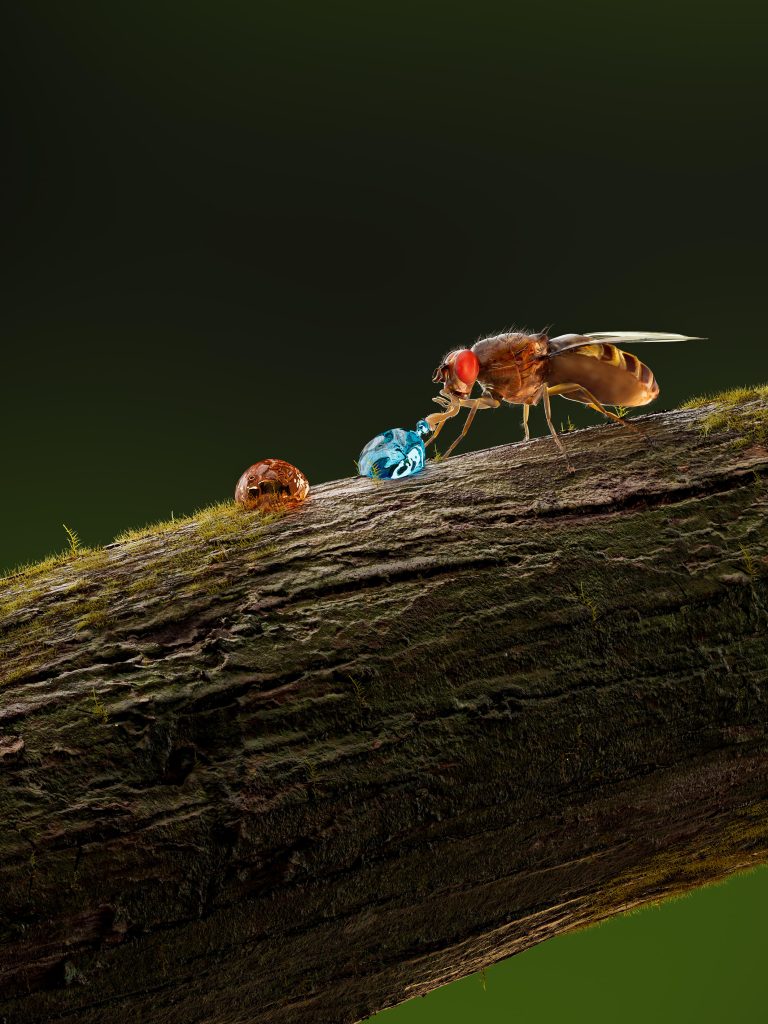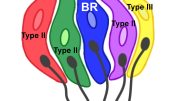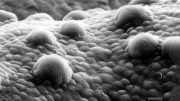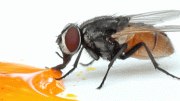
A fruit fly in the wild selects food in the form of dewdrops on a tree branch. The two colors of the food signify a difference in pH, with neutral food in golden brown and the alkaline food in blue. Mi et al. discovered a taste receptor named Alka responsible for sensing alkaline pH. Alka is a chloride channel that is directly activated by hydroxide ions (OH-), enabling avoidance of potentially harmful alkaline foods. Credit: Yali Zhang, Monell Chemical Senses Center
Research using fruit flies sheds light on how other species might identify and steer clear of foods with high alkalinity or pH levels.
The sense of taste plays a vital role in our food experiences as it serves as an initial protective barrier before we ingest it. Despite this, the ability of animals to detect basic or alkaline substances and the underlying processes have long been enigmatic. Recently, a group of scientists, spearheaded by Dr. Yali Zhang, a Principal Investigator at the Monell Chemical Senses Center, has shed light on this intriguing issue much like they did for sour taste in 2021 on the lower side of the pH scale.
Their findings, recently published in Nature Metabolism and highlighted in Nature, identified a previously unknown chloride ion channel, which they named alkaliphile (Alka), as a taste receptor for alkaline pH.
pH, the scale of how acidic or basic a substance is, plays an essential role for living organisms because many biological processes, such as breaking down food and enzymatic reactions, need the level of pH to be just right.
While we are familiar with sour taste, which is associated with acids and allows us to sense the acidic end of the pH scale, little is known about how animals perceive bases on the opposite end of the pH spectrum. Detecting both acids and bases, which are commonly present in food sources, is important because they can significantly impact the nutritional properties of what animals consume.
Zhang’s group found that Alka is expressed in the fly’s gustatory receptor neurons (GRNs), the counterpart of taste receptor cells of mammals. When facing neutral food versus alkaline food, wild-type flies normally choose neutral foods because of the toxicity of high pH. In contrast, flies lacking Alka lose the ability to discriminate against alkaline food when presented with it. If the pH of a food is too high, in humans it can be harmful and cause health concerns such as muscle spasms, nausea, and numbness. Likewise, after fruit flies eat food with high pH, their lifespan can be shortened.
The team’s work demonstrates that Alka is critical for flies to stay away from harmful alkaline environments. “Detecting the alkaline pH of food is an advantageous adaptation that helps animals avoid consuming toxic substances,” said Zhang.
To understand how Alka senses high pH, Zhang’s group performed electrophysiological analyses and found that Alka forms a chloride ion (Cl–) channel that is directly activated by hydroxide ions(OH–). Like olfactory sensory neurons in mammals, the concentration of Cl– inside the fly’s GRN is typically higher than outside this nerve cell.
Zhang proposes that when exposed to high-pH stimuli, the Alka channel opens, leading to negatively charged Cl– flowing from inside to outside the fly’s GRN. This efflux of Cl– activates the GRN, ultimately signaling to the fly brain that the food is alkaline and should be avoided. “Our work shows that Cl– and Cl– channels, which have been overlooked for a long time, have crucial functions in taste signaling to the brain,” said Zhang.
In addition, Zhang’s group studied how flies detect the taste of alkaline substances using light-based optogenetic tools. They found that when they turned off alkaline GRNs, the flies were no longer bothered by the taste of alkaline food. Conversely, they activated these alkaline GRNs by shining red light on them. Interestingly, when these flies were given sweet food and exposed to red light at the same time, the flies did not want to eat the sweet food anymore. “Alkaline taste can make a big impact on what flies choose to eat,” said Zhang.
Overall, Zhang’s group has established that Alka is a new taste receptor dedicated to sensing the alkaline pH of food. In the future, his team aims to explore whether there are analogous high-pH detectors in mammals. “Our work has settled the argument about whether there is a taste for alkaline things,” said Zhang. “There definitely is.”
Research on new taste qualities of animals, including humans, has important implications for understanding dietary habits and developing strategies for improving nutrition.
Reference: “Alkaline taste sensation through the alkaliphile chloride channel in Drosophila” by Tingwei Mi, John O. Mack, Wyatt Koolmees, Quinn Lyon, Luke Yochimowitz, Zhao-Qian Teng, Peihua Jiang, Craig Montell and Yali V. Zhang, 20 March 2023, Nature Metabolism.
DOI: 10.1038/s42255-023-00765-3
The study was funded by the National Institute on Deafness and Other Communication Disorders and the Ambrose Monell Foundation.









Be the first to comment on "Unraveling the Mystery of Alkaline Taste: Scientists Discover a Molecular Basis"